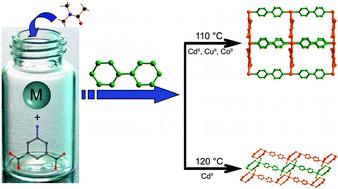Four new compounds, [Cd(5-aip)(bpy)]·1.5DMA (1), [Cu(5-aip)(bpy)]·1.3DMA (2), [Co(5-aip)(bpy)]·1.6DMA (3), and [Cd(5-aip)(bpy)0.5(H2O)]·1.3DMA (4), based on 5-aminoisophthalic acid and 4,4′-bipyridine, have been synthesized by the solvothermal method and structurally determined using single crystal X-ray diffraction. Compounds 1–3 are structurally similar and show non-interpenetrating three-dimensional (3D) pillar-layer frameworks, while compound 4 displays a two-dimensional (2D) (3,4)-connected parallel non-interpenetrating architecture. In all these compounds, 1D rectangular channels are observed and the ligand 5-aminoisophthalic acid exhibits three kinds of coordination modes. Furthermore, 1 displays a single-crystal-to-single-crystal transformation when immersed in a methanol solution. More significantly, 1 can absorb and deliver I2 molecules by means of its channels, and could induce a reversible luminescent transformation from quenching to the initial state. The luminescent properties of 1 and 4 have also been studied.

You have access to this article
 Please wait while we load your content...
Something went wrong. Try again?
Please wait while we load your content...
Something went wrong. Try again?


 Please wait while we load your content...
Please wait while we load your content...